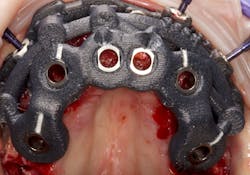The continued evolution of dental implant surgical guides with material innovations
Computed tomography for dental imaging has been available for at least two decades. One of its significant benefits has been the availability of three-dimensional radiology to enable implant planning and the production of surgical guides.
Three things, however, have significantly affected how we plan dental implant placement today and produce all forms of guided devices that enable surgical and prosthodontic execution of a plan. The first of these is the continued evolution of cone beam computed tomography (CBCT). The in-office availability of low-radiation technology that could provide a practitioner with three-dimensional radiological information was pathbreaking at the very least. The second was the evolution of intraoral scanning and the chairside availability of digitization of what was otherwise recordable only as conventional impressions. The third has undoubtedly been the evolution of 3D printing and the in-office availability of a low-cost method to produce surgical and prosthodontic guides.
3D printing has also evolved tremendously over the last five years. Large lab-based, high-cost 3D printers have been able to produce surgical guides for at least two decades, but it is the refinement of this technology into smaller in-office units that accelerated its acceptance. Additive manufacturing is almost an inevitable technological investment for most practices wanting to remain at the cutting edge today. The cost of the hardware involved has also become practical and affordable, and the materials that drive dental applications are constantly expanding and increasingly cost-effective.
You may also be interested in ... The true impact of 3D printing
Traditional surgical guides produced by 3D printing have been made of a relatively clear, dimensionally stable, autoclavable resin for some time. These surgical guides are not necessarily as good as milled resin surgical guides, especially in terms of surface finish, rigidity, and strength. The acceptability of printed resin surgical guides is largely driven by the cost-effectiveness of printed guides versus milled guides. There is also something to be said for the ease of production of printed surgical guides.
The strength of printed resin materials comes into question when larger surgical guides are involved. This is often the case with full-arch surgical guides as well as specialized surgical guides for placement of unique implants, such as zygomatic implants. The strength and rigidity of full-arch surgical guides affect the accuracy of dental implant placement in any cross-arch situation.
For instance, if a surgical guide were to flex due to its material properties, it would significantly influence planned implant position. On the other hand, if a guide were to break intraoperatively, that could potentially mean freehand implant placement or abortion of the procedure altogether.
What is remarkable is that the material industry has addressed these needs, and printing with significantly stronger materials is a reality. Obviously, any materials for guided surgery would have to meet regulatory guidelines for use in a biologic situation and allow an effective method of sterilization. Any guides created by additive manufacturing would also have to have a significant amount of dimensional accuracy to allow the precise placement of guiding sleeves, which are specific to multiple implant systems.
While the fit requirements of a guide on teeth, mucosa, or a bone surface are less demanding, dimensional accuracy is still a significant requirement, if only for sleeves. Let’s look at a few attempts to address the weakness of conventional resin for long-span or large surgical guides, with improvements in material science:
- Polycarbonate—carbon fiber composite
- Metal—selective laser melting or sintering
- Milled grade IV titanium
Polycarbonate—carbon fiber composite
Polycarbonate and carbon fiber materials have been combined into a resin filament that features a high strength-to-weight ratio. The material has extremely high tensile strength, rigidity, thermal resistance, and dimensional stability. These properties make an ideal combination for surgical guides. The guides are manufactured using a fusion deposition manufacturing process in which molten filament is extruded. The extruded material is additively compiled into the shape of a surgical guide component with excellent dimensional accuracy to allow fitting with other sequential components in a full-arch guided surgery workflow. The dimensional accuracy allows precise placement of guided surgery sleeves that in turn allow for accurate execution of a surgical plan.
Selective laser melting/sintering with metal
Selective laser melting or sintering are both additive manufacturing processes. Both processes tend to bypass the physical issues involved with hard milling of metal, reducing incorporated stress and material waste. There are also relatively lower size restrictions on additively manufactured metal surgical guide components, as, hypothetically, you are not affected by milling machine limitations.
In dentistry, most additive manufacturing with metal is called powder bed fusion. Powder bed fusion can be achieved by one of three methods: selective laser sintering (SLS), selective laser melting (SLM), or electron beam melting (EBM). With SLS, metal powder is compacted and transformed into a coherent shape at temperatures below the melting point of the metal. Shapes created by the SLS technique can have a high degree of porosity, and while the porosity can be controlled to some degree, complete elimination is not possible.
SLM, on the other hand, uses either CO2 or fiber lasers to melt powder and allow the creation of a shape. SLM has lower porosity but higher internal stresses, which are caused by thermal gradients during manufacturing. Additional heat treatment is needed to eliminate these stresses. SLM remains the most popular technology for powder bed fusion and additive metal manufacturing in dentistry.
EBM is similar to SLM but uses a focused electron beam in a vacuum environment. This method is not yet popular. Regardless of the type of manufacturing technology used, heat treatment is almost always required to eliminate anisotropy and residual stress. This results in a significant improvement of mechanical properties, essentially fatigue properties. In addition, it is almost always necessary to surface finish any metal components created by additive manufacturing.
Powder bed fusion nevertheless allows for a more flexible design (including even undercuts) and creation of fabricated shapes that may be difficult to achieve by milling. Milling is significantly limited by the size of instrumentation used and the axial access of instrumentation to a material disc. Given the complexity of the multiplanar nature of the anatomic shape of bone, additive manufacturing seems to offer a significant advantage.
Other requirements, such as rigidity, strength, and dimensional accuracy, are easily met by metal. In fact, sleeves can often be designed as part of the main surgical guide structure itself, resulting in a situation where actual insertion of separate sleeves may not be even required. If designed properly, some techniques can also result in incorporation of a metal substructure into a temporary prosthesis as well providing greater strength and predictability during the osseointegration period.
Milled titanium
Milled titanium technology has been around for a long time. Custom abutments and prosthetic frameworks have been routinely fabricated using this technology, especially with grade IV titanium. The technology is also adaptable to different metals or their alloys. Milling continues to be a viable alternative to additive manufacturing even though additive manufacturing is more cost-efficient. Remember that metal additive manufacturing requires a significant hardware capital investment, and milling machines are still far more economical.
Milling also depends on the integrity of a material disc. As long as the disc has been manufactured appropriately, there are no concerns with issues such as porosity. Milling results in an extremely high-quality surface finish, and secondary steps such as heat treatment or surface finishing are not required. Milling has a high precision quality, which means that dimensional accuracy in surgical guides is the best possible. Sleeve dimensions for drills for surgical guides can be also incorporated into the main guide structure, eliminating the need for insertion of company-fabricated sleeves.
The only limitations of milling are instrumentation size and access, but clever CAD design and good CAM software can eliminate many of these issues. Milling will continue to remain a viable alternative. Resin milling is also still an option, and milled resin guides can be stronger that printed resin guides.
Resin guides will continue to be an issue in larger-span frameworks, and that’s where milled metal will come into its own. Milling also means that incorporation of a prosthetic plan into a surgical guide can be far more accurate. For example, if there are custom abutment interfaces or metal prosthetic substructures involved, there is no better technology than milling to produce them. Milling can also work with alternative strong materials, such as technopolymers, especially when considering a prosthodontic substructure.
Conclusion
A significant degree of technological evolution has been happening in the guided surgery space. Navigational surgery, augmented reality, and artificial intelligence will significantly drive future innovations as the technologies are refined. For now, however, surgical guides remain the mainstay of predictable implant surgery and prosthodontic plan execution. Material innovations have greatly improved conventional implant surgical guides and will ensure that they continue to remain relevant.
Editor's note: This article appeared in the July 2023 print edition of Dental Economics magazine. Dentists in North America are eligible for a complimentary print subscription. Sign up here.
About the Author

Nitish Surathu, MDS, BDS
Nitish Surathu, MDS, BDS, practices in New Zealand. He is an associate fellow of the American Academy of Implant Dentistry, and a fellow and diplomate of the International Congress of Oral Implantologists. He has lectured internationally on periodontics, dental implants, and digital dentistry. Dr. Surathu is a director with the ACE Institute and digitaldentition.com, and is involved in evaluating new-generation digital technologies.
Updated June 7, 2023

Neeraj Surathu, BDS
Neeraj Surathu, BDS, is a current postgraduate prosthodontic resident at Nova Southeastern University in Florida. After completing his BDS, he went on to work as a dental lab technician in New Zealand, where much of his work revolved around digital workflows. His interest in digital dentistry saw him commence a formal postgraduate prosthodontics program in 2021. Dr. Surathu has a keen interest in all things dental and digital besides surgical prosthodontics and artificial intelligence.






